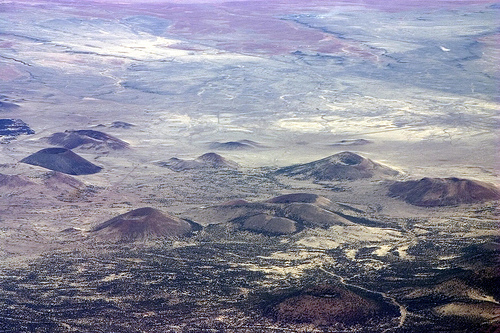 | Volcanoes, Az |
The Hopi Buttes volcanic field consists of ~300 late Miocene volcanic centers within ~ 1800 km2 of the field, located in northeastern Arizona (see Figure 1). Excellent cross-sectional exposures of well-preserved diatremes, vents, and related maar-crater deposits are exposed in the cliffs of the lava-capped mesas and buttes of the area (See Figure 2). Vents in the eastern part of the field preserve surficial maar deposits while vents in the western part preserve the sub-volcanic ōplumbingö system or diatreme. The maars formed through explosive interaction of groundwater, liquefied lower Bidahochi sediments, and/or lake water with monchiquitic and nephelinitic magmas. The ratio of water to magma during the eruptions may have controlled the type of landform produced, which includes maars (including tuff rings and exposed diatremes), scoria cones, and lava flows. The style of eruption ranged from phreatomagmatic to magmatic and the morphologic characteristics of some vents, particularly maars and tuff rings are typical of eruptions that occur in wet, low-lying areas. Clay-rich tephra of the maars indicate explosive interactions of magma with a clay-water slurry, inferring that molten fuel-coolant interactions involving magma and wet-sediment are important in maar and diatreme emplacement. The Hopi Buttes volcanic field is one of the few places in the world in which an entire suite of maar crater deposits, tephra aprons, and underlying diatremes is exposed. My research involves describing marginal deposits of the maar craters from the north-central portion of the volcanic field. Located mostly on Navajo Nation land, the Hopi Buttes occur on the southwestern Colorado Plateau. Throughout Cenozoic time, the Colorado Plateau has remained a relatively stable tectonic feature. Lithospheric boundaries of Proterozoic provinces probably lie beneath the Colorado Plateau and possibly beneath the Hopi Buttes volcanic field. The Hopi Buttes is one of a few volumetrically significant areas of late Tertiary volcanic activity on the Colorado Plateau that produced basanites, nephelinites, and monchiquites (all three are silica undersaturated with high alkali values basalts) - http://azgeology.azgs.az.gov/archived_issues/azgs.az.gov/arizona_geology/spring10/article_earthscience%20.html |
|
http://en.wikipedia.org/wiki/San_Bernardino_Valley_(Arizona)- The Geronimo volcanic field (also known as the San Bernardino volcanic field) is a monogenetic volcanic field in southeastern Arizona
The calderas of the Boot Heel field include:[2]
Pyramid Mountains
Muir caldera 35.3 Ma
Peloncillo Mountains
Steins caldera 34.4 Ma
Animas Mountains
Juniper caldera 33.5 Ma
Animas Peak caldera 33.5 Ma
Tullous caldera 35.1 Ma
Chiricahua Mountains
Geronimo Trail caldera 32.7 Ma
Clanton Draw caldera 27.4 Ma
Portal caldera 27.6 Ma
Turkey Creek caldera 26.9 Ma
Arizina craters - http://en.wikipedia.org/wiki/Boot_Heel_volcanic_field
http://volcano.oregonstate.edu/vwdocs/volc_images/north_america/arizona/navajo.html navajo volcanic field
The Navajo volcanic field
http://www.denison.edu/academics/departments/geosciences/fieldtrips/may_2001_field_trip.html trip
http://arizonageology.blogspot.com/2011_02_01_archive.html
http://scienceblogs.com/eruptions/2009/12/mvp_18_antelope_hill_az.php
http://geology.com/satellite/arizona-satellite-image.shtml arizona
http://www2.brevard.edu/reynoljh/FTWeb/p1.html
http://en.wikipedia.org/wiki/San_Bernardino_Valley_(Arizona)- The Geronimo volcanic field (also known as the San Bernardino volcanic field) is a monogenetic volcanic field in southeastern Arizona
The calderas of the Boot Heel field include:
Pyramid Mountains
Muir caldera 35.3 Ma
Peloncillo Mountains
Steins caldera 34.4 Ma
Animas Mountains
Juniper caldera 33.5 Ma
Animas Peak caldera 33.5 Ma
Tullous caldera 35.1 Ma
Chiricahua Mountains
Geronimo Trail caldera 32.7 Ma
Clanton Draw caldera 27.4 Ma
Portal caldera 27.6 Ma
Turkey Creek caldera 26.9 Ma
Arizina craters - http://en.wikipedia.org/wiki/Boot_Heel_volcanic_field
http://volcano.oregonstate.edu/vwdocs/volc_images/north_america/arizona/navajo.html navajo volcanic field
see picture - Death Valley http://geotripper.blogspot.com/

